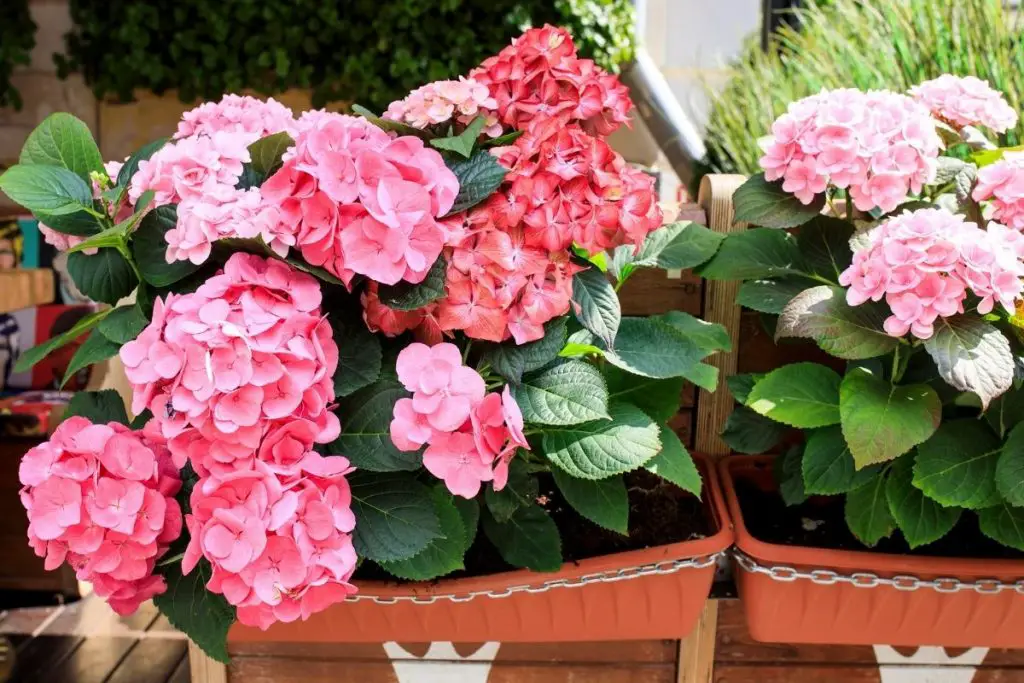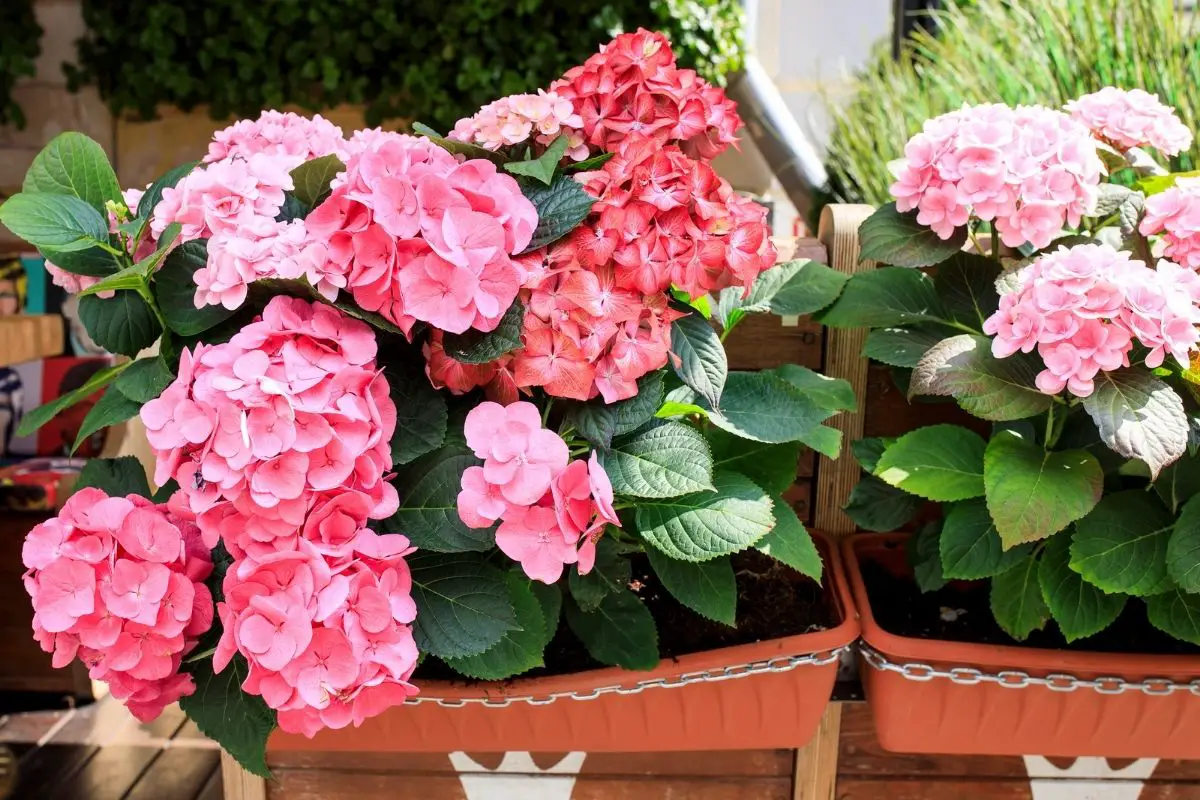Everyone loves the majesty of the large, showy blooms of the hydrangeas that come back into flower each summer, year after year. But not everyone has the space for a mature plant to spread and grow in their gardens.
The good news is that there is a great choice of dwarf varieties available, so you can take your pick and enjoy the show! Even if you only have a balcony, you can grow a dwarf hydrangea plant in a pot. A dwarf hydrangea is just a small version of the standard plant.
History
Dwarf or semi-dwarf hydrangeas first appeared in Europe over sixty years ago, but it is really only in the last twenty-five years that dwarf hydrangeas have been developed on a large scale to produce the big mophead flowers that we are used to seeing in the H. macrophylla varieties.
Such plants were developed to enable growers to raise pot-grown species of hydrangea plants without the need for growth inhibitors.
Plant Facts
| Scientific name | Hydrangea macrophylla “paraplu”, H. macrophylla “cityline Rio”, H. macrophylla “mini Penny”, Hydrangea paniculata “little lime”, Hydrangea quercifolia “pee wee” |
| Common names | Dwarf mophead hydrangea, Mini PennyDwarf tree hydrangea, Little LimeDwarf oak-leaf hydrangea, Pee Wee |
| Genus | Hydrangea |
| Family | Hydrangeaceae |
| Height | Up to 4 feet |
| Width | Up to 4 feet |
| USDA Plant Hardiness Zone | 3 to 9 |
| Native to | Asia, America |
| Blooming season | summer |
| Flower colors | Red, pink, blue, white |
| Plant specific features | Compact perennial shrub grown for its display of summer flowers |
How to Plant and Grow Dwarf Hydrangeas
A dwarf hydrangea shrub has been specially grown for container growing or for planting out in a small space. A dwarf hydrangea is a miniature version of the standard plant, whether an oakleaf, tree or mophead hydrangea bush.
Outdoor planting is recommended. It is difficult to grow any type of hydrangea indoors. Regulating indoor watering, and providing the optimum amounts of sunlight and shade can all prove challenging. Added to this, many indoor varieties of dwarf hydrangea bushes have been specially produced for flowering displays in pots, but only for a short period of time. They are not designed for long-term use.
Like any pot-raised hydrangea bush, a pot-grown dwarf hydrangea can be planted throughout the year, but it is strongly advised to avoid planting out during extremes of weather. If you plant during the height of summer or the depths of winter, there is a likelihood that the plant will become stressed and prone to disease.

Care and Maintenance
Here are some important care tips for a mini hydrangea:
Soil
Like their standard-sized cousins, small hydrangea plants like to be planted in free-draining soil that is enriched with organic matter.
Water
Once again, like a larger variety, a dwarf hydrangea bush needs to receive plenty of water, especially during the flowering season. This helps to prevent the plant from wilting on hot days. Any newly planted hydrangea needs to be kept moist until it has established a robust root system and is able to absorb nutrients and moisture from the soil.
Fertilizer
An all-purpose, slow-release fertilizer will provide a simple but effective fertilizing solution for all your hydrangea shrubs or trees. Only fertilize in the spring or summer. Once the flowers are over, it is not a good idea to apply fertilizer, as the plant needs to prepare for winter dormancy and not be encouraged to produce new growth at this stage of the season.
Sunlight
Most hydrangea plants will flower better if they receive an adequate amount of morning sun. However, they also need to be protected from the searing afternoon heat. Dappled shade or a north-facing position can provide a good site.
Humidity and Temperature
An extended period of cool temperature is required to form flower buds. Protect the plant from extreme weather, including strong wind, scorching sun, and prolonged excessive frost.
It is generally considered that the majority of hydrangea plants are cold hardy to USDA zone 4. Mini hydrangea bushes need plenty of watering during the flowering season, but their roots must not sit in waterlogged soil.
Pruning
Different varieties of hydrangea bushes require different pruning techniques; some hydrangeas flower on old wood, others only on new growth.
H. macrophylla is a hydrangea that flowers on old wood. For dwarf varieties of this species, pruning should take place as soon as possible after flowering. The dwarf varieties of the H. macrophylla include “Pia”, and “Cityline”.
Conversely, dwarf varieties of H. arborescens and H. paniculata (tree hydrangea), bloom on new wood. For these, pruning needs to take place late fall or in the winter before new shoots start to develop.
After pruning has been completed, for optimum results, apply a layer of organic matter as a mulch around the base of the plant. This will encourage healthy new shoots to form, as well as retaining moisture in the soil and suppressing weeds from around the roots.
Pest and diseases
As with the larger species, dwarf hydrangeas do not suffer unduly from pests and disease. Providing the roots do not sit in waterlogged soil, and they are not stressed by too much heat, wind, or sun, they are a reliable and robust plant. Too much humidity, caused by a prolonged spell of cold, damp days, can lead to a fungal disease.
One of the most common diseases is blight, which can adversely affect the flower buds and even destroy them before they open. To avoid this, keep a good circulation of air movement around the base of the plant. You can do this by making sure to keep the plant clear of dead and decaying vegetation, pruning and cutting branches to give the plant room to breathe. If this isn’t sufficient to cure the problem, you may have to resort to using a fungicide. The most common pests are slugs, aphids, and spider mite, which can often be controlled effectively by just a strong jet of water from the hosepipe.
Uses of Dwarf Hydrangeas
One of the most attractive ways to use dwarf hydrangeas is to plant them in pots on a patio, terrace or around a pool. The pink flowers of dwarf hydrangea bushes look spectacular when combined with a trailing plant and the pot becomes filled with deep green, glossy leaves.
Common Varieties and Cultivars
The main types of hydrangea which are widely grown are H. macrophylla (mophead), H. paniculata, (tree hydrangea), H. Quercifolia (oakleaf hydrangea).
Conclusion
What’s not to love about small hydrangeas? With the huge range of dwarf hydrangeas available, it is possible to bring color and big blooms into even the smallest of spaces whilst maintaining a compact and tidy growing plant.
~ image source: depositphotos/elenarostunova

